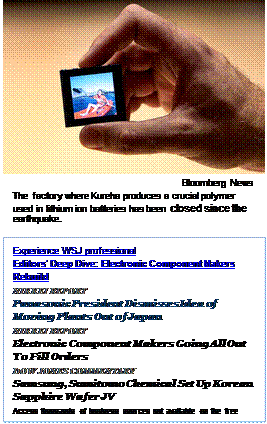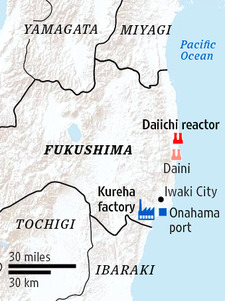Chemical Reaction: iPod Is Short Key Material
By MARIKO SANCHANTA
TOKYO—A representative from Apple Inc. recently called Kureha Corp.'s offices in the U.S. The problem: Apple was facing tight supplies of lithium-ion batteries used in its popular iPods, and they traced the supply bottleneck to the relatively obscure Japanese chemicals maker.
Kureha, which has a 70% share of the global market for a crucial polymer used in lithium-ion batteries, had to shut its factory in Iwaki—near the quake's epicenter—after the March 11 disaster struck. It is the only place where Kureha makes this particular polymer.
 Its chief executive said Japan's natural disaster would accelerate the company's plans to move more of its production overseas. "For a company like Kureha, this is the only way of surviving," said Takao Iwasaki in an interview on Monday.
Its chief executive said Japan's natural disaster would accelerate the company's plans to move more of its production overseas. "For a company like Kureha, this is the only way of surviving," said Takao Iwasaki in an interview on Monday.
Apple didn't respond to a request for comment.
The disaster in Japan—and the resulting disruptions to production—has shone a spotlight on companies that aren't well-known outside of Japan but globally dominant, such as Kureha. These companies have carved out a niche as high-end producers of advanced components and materials, and therefore have an outsize role in their individual global markets.
It has also put increased attention on the years-long move by Japanese manufacturers to shift work to other nations, both to reduce costs and compensate for the frequent fluctuations of the yen. Economists are watching to see whether the March 11 earthquake and tsunami, which have heavily damaged Japan's power grid and supply chain, will affect the trend.
Kureha's polymer—made from a resin known as polyvinylidene fluoride, or PVDF—is used as a binder in lithium-ion batteries. Kureha's Iwaki factory has been closed since the quake hit, and the company is unsure as to when it will start up again.
The Iwaki factory came out of the quake in decent shape, but Onahama Port nearby is severely damaged, and crucial supplies such as vinyl chloride and salt aren't reaching the factory yet.
"After the disaster, we got so many calls—'How much inventory do you have?' and, 'How quickly can you send it to us?' " said Mr. Iwasaki, 63 years old. "Even before this disaster, we were already thinking about shifting some of our production to the States and China. We will now accelerate these plans."
Vishal Sapru, a market researcher with the firm Frost & Sullivan, said the kind of polymer supplied by Kureha is essential for the current breed of batteries, which are pliable rather than rigid—making it easier to squeeze them into small or irregular spaces in compact electronics products.
 He expects the potential shortage to affect other devices than the iPod. "It will be a problem in many mobile products that use lithium polymer batteries," Mr. Sapru said.
He expects the potential shortage to affect other devices than the iPod. "It will be a problem in many mobile products that use lithium polymer batteries," Mr. Sapru said.
Kureha currently has factories in the U.S., China and Vietnam, though none produce PVDF. The company said it can't yet quantify the financial impact of the plant closure. Mr. Iwasaki said Kureha's insurance doesn't cover the company's lost revenue because of the closure. For some products, Kureha has about two months' worth of inventory, though these supplies are quickly diminishing.
Mr. Iwasaki stressed the need to keep the research and development and technology in Japan, however. "We spent more than 30 to 40 years developing this—it is our treasure," he said. "These technologies should be kept in Japan, and Japan should be the base for the mother plant."
The day the quake struck, Kureha's entire board was meeting in Iwaki City. Some managed to drive back to Tokyo the same night, taking at least 12 hours.
Mr. Iwasaki stayed until Sunday, ensuring the safety of his employees and the plant. None of the plant's 800 workers were seriously injured or went missing.
Now, he said the biggest challenge is monitoring the daily situation at the damaged nuclear reactors in Fukushima prefecture. Kureha's Iwaki plant is about 37 miles away.
Mr. Iwasaki has been urging employees to stay in the region. "We cannot run away," he said. "We must believe the government information and support the local communities. We have to behave bravely."
—Don Clark contributed to this article.
Copyright 2011 Dow Jones & Company, Inc. All Rights Reserved
QUESTIONS:
1. Apple is running short of ion-lithium batteries. What did Apple ascribe the shortage to? Where did the key bottleneck lie? What does this imply about the pros and cons of having global supply chains?
2. What kind of a firm is Kureha? Why did it make sense on paper for Kureha not to internationalize the production of PVDF? Give at least three different good reasons!
3. Based on this one exceptional disaster, should Kureha begin to internationalize the production of PVDF? Or can Kureha assume a disaster of this scale will not repeat itself?
4. What can or should Apple and other key customers of Kuhera do about the situation? Based on this one exceptional disaster, do they need to become proactive in rethinking the sourcing of critical components like PVDF? If so, what are their options?
5. Can the situation be considered as a crisis? Who are concerned and how? Is there reputation involved?
6. What kinds of crisis do you know? What are the rules for crisis communications? Were they used by companies involved and in what way?
7. Do you see any cross-cultural aspects of crisis communications in this situation? Are there any cultural values involved?
8. Who is supposed to be the source for publication? Who is supposed to be the target for the message?
9. What is the purpose of publication?
10. What is the basic idea of the article?
Reviewed By: Mark Lehrer, Suffolk University. Adapted by I.Alyoshina